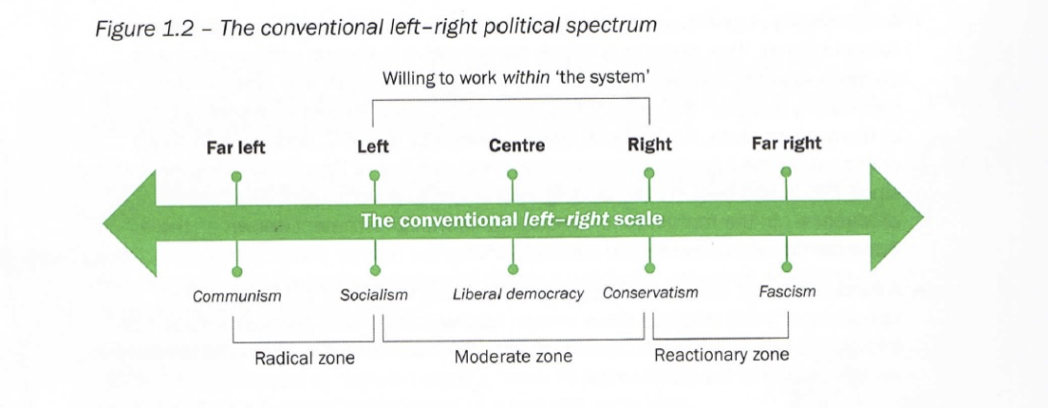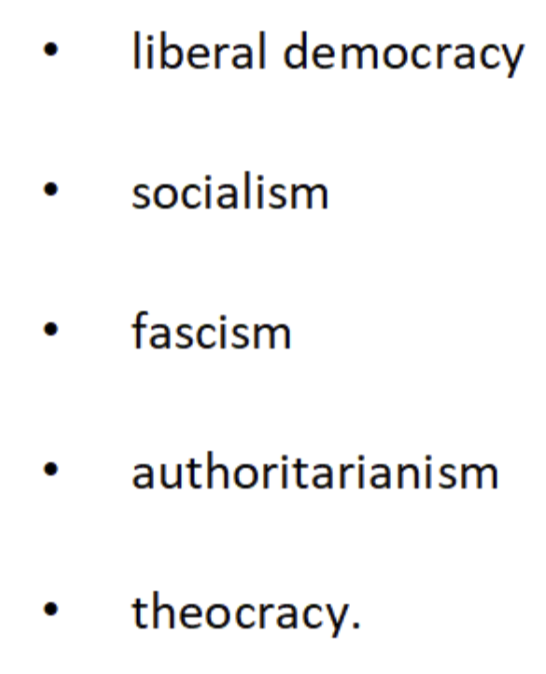VCE Australian & Global Politics Unit 1 AOS 1
Key Terms and Concepts
- Liberal democracy: individual freedoms and rights are recognised and protected and it emphasises the separation of powers
- Representative democracy: When the citizens elect people to represent them in the legislative branch
- Constitutional monarchy: A political system with a monarch, and their authority and powers are defined by the constitution
- Socialism: A left wing political ideology which revolves around the belief that the government should own production and wealth on the people’s behalf
- Fascism: A right wing political ideology which usually has a dictatorial leader and their severe beliefs of nationalism, authoritarianism and anti-democracy
- Authoritarianism: A system of government characterised by a strong central government and limited democratic rights and freedoms.
- Theocracy: A governmental system that centres religious beliefs
- Ideology: A set of values and beliefs a group of people have in common regarding how the world should be organised politically
- Political power: The use of a state’s internal political machinery to influence citizen’s actions. Ex. legislation, executive orders
- Authority: The power of a person or group over other people in a political power context
- Legitimacy: When political power is widely accepted by the population, typically through democratic means
- Federalism: A government system where law making powers are separated between a national/central government and state/regional governments
- Separation of powers: The three branches of government (parliament, executive and judiciary) should be kept separate from each other to avoid abuse of power and power is evenly distributed
- Representative government: A political system where the legislative and executive branches are operated by elected citizens on behalf of the people
Political Spectrum and Labelling 
Left-wing: This political label emphasises progress, reform and social equality
Right-wing: This political label is based on conservative beliefs, reaction and tradition
Conservative: This political ideology focuses on traditional family structures and social values
Moderate: Rejecting extreme viewpoints and having a mainstream
Liberal: Believing in equality, freedom and human rights
Reactionary: Someone who wants to revert to traditionalism and reverse political changes
The Characteristics of Australian Democracy
- A written constitution (1901)
- Appointed head of state (King Charles III)
- Federal Government
- Westminster parliamentary government - Bicameral system
- Mandatory participation in elections
- Dominance of major parties - Australian Labor Party and Liberal Party of Australia
Political Ideologies

Socialism:
- entails economic + political systems → support the belief that property, production and resources should be publicly owned + should be a even distribution of wealth
- allow for equality within society and dismantle social classes
- all members are responsible for a resource → gives them entitlement to a share
- ideals based on the principle that independent freedom and co-dependency are reliant on each other
- members must control production to access freedom
- left leaning ideology → countering capitalism
Key Beliefs of Socialism:
- production is publicly owned
- social equality
- self-managed economy
- even distribution of income
Liberal Democracy
Principles + Features of Liberal Democracy
- Principle 1: Rule of law
- Everyone is equal before the law
- Principle 2: Consent of the Governed
- Government needs our permission to govern us or else the power they possess is not considered legitimate
- Principle 3: The Separation of Powers
- Ensures that power is evenly distributed between the three branches
- Prevents abuse of powers or one branch dominating over the others
- Judiciary branch: Makes judgements on law, represented by the High Court of Australia
- Parliament branch: Make and change law, represented by the upper and lower house and the King (Governor-General)
- Executive branch: Put law into action, represented by the King (Governor-General), Prime Minister and ministers
- Feature: Freedom and Liberty
- Eradicate the constraints of individual actions
- Pursue own interests
- Feature: Opposition to the concentration of power in one person
- Links to the separation of powers.
- Directly counters dictatorships or governments with one-party systems.
- Feature: The rule of law and due process
- Ensures that the law applies to everyone, despite factors such as socioeconomic status, gender, position of power, etc
- Transparency and openness in processes
Authoritarianism
- Based on the principle of blind loyal to government bodies at the expense of individual rights and freedoms
- Power in one person or group → lack of political opposition
- Have total control and can exercise power while ignoring pre-existing legislation
- Policy remains consistent for the duration of the leadership
- Citizens cannot vote in elections to alter bad policies
- Change policies through intense measures like violence
- Limited liberty → eg. censorship in the media
- Lack of choice in property rights
Case Study of a Non-Democratic Party
Cuba - Socialism
- Communist Party of Cuba is the only major party
- Political System: One state - one party
- Governing style: Marxist-Leninist, Socialism
- 1959 Cuban Revolution → Made Cuba into a one-party state
- Government controls 90% of the economy
- Workers’ salaries are evenly distributed as a trade-off for healthcare, education, inexpensive transport, and housing, etc
- Provided housing is in poor condition
- Cubans create their own businesses secretly to not pay heavy taxes and pay for a government business license
- Cuba legalised private small/medium businesses in 2021 as a result of people protesting about the economic collapse → Socialism is ineffective
China - Communism
- Political System: Democratic dictatorship or Socialism w/ Chinese characteristics
- The Communist Party of China
- Political System: One-party state
- Princeling Faction: Come from families of revolutionaries or high ranking individuals
- Economically well-developed coastal cities
- Financial beneficiaries
- Populist Faction: Advance in politics through the Chinese Communist Youth League
- AKA tuanpai → league faction
- Representing farmers, migrant workers, urban poor, etc
- Politburo Standing Committee: The core leadership group of CPC that enacts and amends all laws
- Comprised of 5-7 members who make decisions on major issues
- Highest level of executive government
- Transfer of power in the CPC is an internal matter
- Protections of rights and freedoms: Deemed an authoritarian society, has power over the citizens’ lives, less free and independent media outlets, prioritises economic rights over political freedoms
Tiananmen Square Case Study
- Date: 3-4 June 1989
- Gov. cracked down on protesters in Tiananmen Square → uni students wanted more individual rights + freedoms
- 22 April 1989: Hu Yaobang’s CCP Secretary encouraged democratic reforms
- Funeral: students gathered to demand gov. reform
- Chinese premier + elder statesman insisted on sup
- pressing protests
- 3-4 June 1989, tanks + armed troops opened fire on people blocking their way
- When soldiers reached the square, thousands of demonstrators left
- 5 June 1989: Military had complete control → incident where lone protester faced down a column of tanks near the square → pulled away by 2 men
- Chinese gov. arrested suspected people who might have opposed the gov.
- Government kill count: 241, 7000 wounded
- other estimates have higher death toil
- Gov. suppresses reference to this incident
Compare the Communist Party of China’s ideologies with the Australian Liberal Party
| CPC | Both | ALP |
|---|---|---|
| socialist values | democratic deliver economic growth | minimise interference in people’s lives |
| dictatorship | improving livelihood of citizens | opposing political parties |
| dominates Chinese political life | deliver economic growth | individual freedoms |
| no true opposition or toleration for oppositions | objective to have separation of powers | |
| no separation of powers | liberalism | |
| censorship in the media | no censorship in the media | |
| Marxist-Leninist | ||
| economic growth prioritised over individual rights and freedoms |
Formal and Informal Politics
- Formal politics: The dominant frame of reference when considering the nature of politics.
- Global actors who are prominent in the media and such
- Informal politics: Power structure of personal relations between people to obtain power
- Eg. everyday politics: Friendship group at school, workplace gossip, couple parting ways
- Hierarchies, laws, ideologies, codes of conduct, power struggles
Power
- Power: The ability to direct people’s behaviour and have authority over others
- Hard power: When an actor uses force and coercion to get what they want
- Threatened with money or a material/monetary incentive
- Actor A wins, Actor B loses
- Eg. North Korea’s military system → use of 25% of GDP on military
- Soft Power: The use of appeal and attraction to achieve goals
- Actor A appeals to Actor B so they want the same thing → Actor A strategically makes situations to make the win favourable for Actor B
- Eg. Australia’s government system → focus on building connections with other countries with Australia’s internet at large